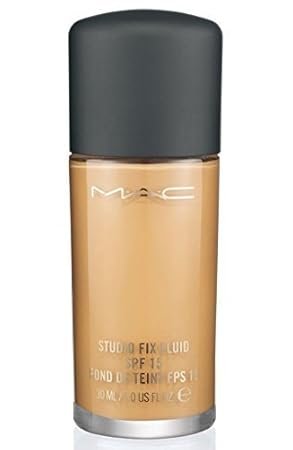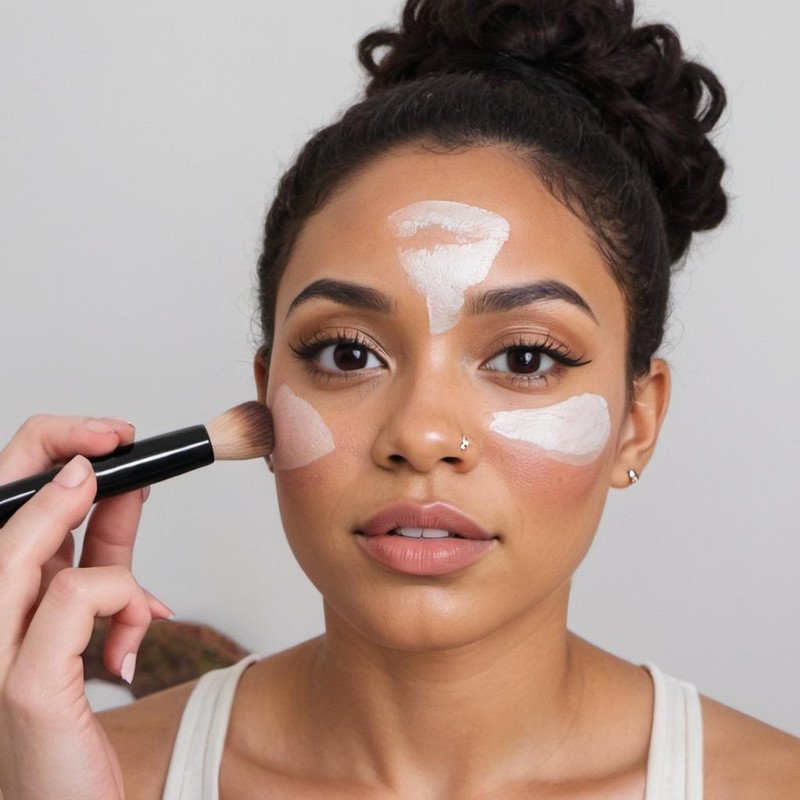MAC Studio Fix Fluid Foundation NC25 Review: My Honest Thoughts

Welcome, makeup enthusiasts! Today, I’m diving deep into a product that’s been a staple in many makeup bags for years: the MAC Studio Fix Fluid Foundation in the shade NC25. This foundation boasts a long-wearing formula, medium-to-full buildable coverage, and a matte finish. But does it live up to the hype? After extensive testing, I’m here to share my honest thoughts, experiences, and everything you need to know before deciding if this foundation is right for you. Let’s explore the pros and cons of this iconic foundation.
First Impressions and Packaging
The MAC Studio Fix Fluid Foundation comes in a sturdy glass bottle, which feels quite luxurious. However, it’s worth noting that it doesn’t come with a pump. You’ll need to purchase one separately, which is a bit of an inconvenience and an additional cost. The lack of a pump can also make dispensing the product a little messy. The packaging is simple and functional, true to MAC’s aesthetic. The shade number is clearly marked on the bottle, which is helpful when you have multiple foundations in your collection. Initial impressions leaned towards a professional-grade product.
Shade Matching: Finding My Perfect NC25
MAC’s shade range is renowned for its inclusivity, and finding my perfect match (NC25) was relatively easy. NC stands for Neutral Cool, meaning it has slightly yellow undertones that counteract redness. It is important to note that getting the right shade online can be tricky. I recommend visiting a MAC counter for a professional shade match if possible. If you are unable to visit the counter, look for online tools. Many websites offer virtual try-on features. Comparing swatches with other foundations you already own is a great idea. Also, it’s worth noting that the foundation can oxidize slightly, so keep that in mind when choosing your shade.
Application Techniques and Tips

I’ve experimented with various application methods to see what works best for this foundation. Here’s what I’ve found:
- Beauty Sponge: A damp beauty sponge provides a more natural, airbrushed finish. It sheers out the coverage slightly, making it ideal for everyday wear.
- Foundation Brush: A dense, flat-top foundation brush offers the fullest coverage. It’s great for special occasions or when you want to conceal imperfections.
- Fingers: Applying with fingers warms up the product, making it easier to blend. It’s a good option for light coverage and a quick application.
Regardless of the method you choose, make sure to start with a well-moisturized and primed face for the best results. Also, work in thin layers to avoid a cakey appearance. Remember that a little goes a long way with this foundation.
Coverage and Finish: Achieving a Flawless Look
The MAC Studio Fix Fluid Foundation offers medium-to-full buildable coverage. One layer evens out the skin tone and covers minor imperfections. Two layers can conceal blemishes and redness effectively. The finish is a true matte, which can be a pro or con depending on your skin type and preference. If you have oily skin, you’ll appreciate the oil-controlling properties of this foundation. However, if you have dry skin, you might find it a bit too drying. For a more natural look, I recommend mixing a drop of facial oil or hydrating serum into the foundation.
Wear Test: Longevity and Performance Throughout the Day
One of the biggest claims of the MAC Studio Fix Fluid Foundation is its long-wearing formula. I put it to the test on several occasions, from long workdays to evenings out. Here’s what I observed:
- Oily Skin: It controls oil production for a good 6-7 hours before needing to blot. It doesn’t completely eliminate shine, but it does a decent job of keeping it at bay.
- Combination Skin: The T-zone tends to get oily after about 5 hours, while the rest of the face stays relatively matte.
- Dry Skin: It can cling to dry patches and accentuate texture if the skin isn’t properly moisturized beforehand.
Overall, the foundation holds up well throughout the day. It doesn’t fade or transfer easily, even in humid conditions. Setting it with a good powder can further extend its wear time.
Oxidation: Does the Shade Change Over Time?
As mentioned earlier, the MAC Studio Fix Fluid Foundation can oxidize slightly, meaning the shade can deepen or turn more orange after it’s been applied to the skin. This is something to be aware of when choosing your shade. I’ve noticed that NC25 oxidizes a bit on my skin, so I prefer to use a slightly lighter shade in the winter months. It’s always a good idea to test the foundation on your jawline and check the color after a few hours to see how it oxidizes on your skin.
Suitable Skin Types: Who Will Love This Foundation?
The MAC Studio Fix Fluid Foundation is best suited for those with oily or combination skin. Its matte finish and oil-controlling properties make it a great choice for keeping shine at bay. If you have dry skin, you can still make it work by using a hydrating primer and moisturizer, but be prepared to add some extra hydration throughout the day. Those with mature skin may want to avoid this foundation, as its matte finish can accentuate fine lines and wrinkles.
Pros and Cons: A Balanced Perspective
Here’s a quick rundown of the pros and cons of the MAC Studio Fix Fluid Foundation:
| Pros | Cons |
|---|---|
| Long-wearing formula | Can be drying for some skin types |
| Medium-to-full buildable coverage | Doesn’t come with a pump (sold separately) |
| Extensive shade range | Can oxidize slightly |
| Matte finish (good for oily skin) | May accentuate texture on dry skin |
| Controls oil production | Can look cakey if not applied correctly |
Comparing MAC Studio Fix Fluid to Other Foundations
Let’s see how the MAC Studio Fix Fluid Foundation stacks up against some popular alternatives:
| Foundation | Coverage | Finish | Longevity | Price |
|---|---|---|---|---|
| MAC Studio Fix Fluid | Medium-Full | Matte | Long-wearing | $$ |
| Estée Lauder Double Wear | Full | Matte | Very Long-wearing | $$$ |
| NARS Natural Radiant Longwear Foundation | Medium | Radiant | Long-wearing | $$$ |
| L’Oréal Infallible Pro-Matte Foundation | Medium | Matte | Long-wearing | $ |
As you can see, the MAC Studio Fix Fluid offers a good balance of coverage, longevity, and price. However, if you prefer a more radiant finish, you might want to consider the NARS Natural Radiant Longwear Foundation. If you’re on a budget, the L’Oréal Infallible Pro-Matte Foundation is a great alternative.

The Importance of Skincare Before Foundation
No matter how good a foundation is, it will only look as good as the skin underneath. Proper skincare is essential for achieving a flawless complexion. Before applying the MAC Studio Fix Fluid Foundation, make sure to follow these steps:
- Cleanse: Start with a gentle cleanser to remove dirt, oil, and makeup residue.
- Exfoliate: Exfoliate 1-2 times a week to remove dead skin cells and improve skin texture.
- Moisturize: Hydrate your skin with a moisturizer that’s suitable for your skin type.
- Prime: Use a primer to create a smooth canvas for your foundation and extend its wear time.
Investing in a good skincare routine will not only improve the appearance of your makeup but also enhance the overall health and radiance of your skin.
Setting Your Foundation: Powder or No Powder?
Setting your foundation with powder is a crucial step for extending its wear time and preventing shine. However, it’s not always necessary, depending on your skin type and the look you’re going for. Here are some guidelines:
- Oily Skin: Use a setting powder, especially in the T-zone, to control oil production and prevent the foundation from sliding off.
- Combination Skin: Apply powder to the T-zone and any other areas that tend to get oily.
- Dry Skin: Skip the powder or use a very light dusting of translucent powder to avoid further drying out the skin.
When choosing a setting powder, opt for a finely milled formula that won’t look cakey or settle into fine lines. Loose powder provides a more natural finish than pressed powder.
The Role of Primer in Achieving a Flawless Base
Primer is an often overlooked but essential step in achieving a flawless foundation application. It creates a smooth canvas for your foundation, extends its wear time, and can address specific skin concerns. Here are some types of primers and their benefits:
- Hydrating Primer: Adds moisture to dry skin and prevents the foundation from clinging to dry patches.
- Mattifying Primer: Controls oil production and minimizes shine.
- Pore-Filling Primer: Blurs pores and creates a smooth, even surface.
- Color-Correcting Primer: Neutralizes redness, sallowness, or discoloration.
Choose a primer that’s suited to your skin type and concerns for the best results. Apply a thin layer of primer after moisturizing and before applying foundation.
Removing Your Makeup Properly: A Crucial Step
Removing your makeup properly is just as important as applying it. Sleeping in your makeup can clog pores, lead to breakouts, and accelerate the aging process. Here’s a step-by-step guide to removing your makeup effectively:
- Makeup Remover: Use a makeup remover (such as micellar water or cleansing oil) to dissolve makeup, dirt, and oil.
- Cleanse: Follow up with a gentle cleanser to remove any remaining residue.
- Tone: Use a toner to balance the skin’s pH and remove any impurities.
- Moisturize: Hydrate your skin with a moisturizer to replenish moisture and prevent dryness.
Consider using a double cleansing method that involves first using an oil-based cleanser to remove makeup and then following up with a water-based cleanser to ensure all impurities are removed.
Final Thoughts: Is MAC Studio Fix Fluid Foundation Worth It?
So, is the MAC Studio Fix Fluid Foundation worth the investment? In my opinion, it depends on your skin type and preferences. If you have oily or combination skin and are looking for a long-wearing, medium-to-full coverage foundation with a matte finish, then it’s definitely worth considering. However, if you have dry skin or prefer a more dewy finish, you might want to explore other options. While the lack of a pump and the potential for oxidation are minor drawbacks, the overall performance and shade range make this foundation a popular choice for many makeup lovers. Despite these issues, it remains a product I find myself going back to.
Alternatives to Consider
- Estee Lauder Double Wear: Another long-lasting, full-coverage option that’s great for oily skin.
- NARS Natural Radiant Longwear Foundation: Offers medium coverage with a radiant finish, suitable for normal to dry skin.
- L’Oreal Paris Infallible 24HR Fresh Wear Foundation: A more affordable option that provides medium coverage and a natural finish.
- Fenty Beauty Pro Filt’r Foundation: Known for its wide shade range and matte finish, ideal for oily skin.
Each of these foundations caters to different skin types and preferences, so consider your individual needs when making a choice.
Tips for Making Your Foundation Last Longer
- Start with a good primer: A primer creates a smooth base and helps your foundation adhere better to your skin.
- Set with powder: Use a translucent setting powder to lock your foundation in place, especially in areas prone to oiliness.
- Use a setting spray: A setting spray helps to meld all your makeup together and extends its wear time.
- Avoid touching your face: Touching your face throughout the day can transfer oils and break down your foundation.
- Blot instead of wiping: If you get oily, blot with blotting papers instead of wiping, which can remove your foundation.
Common Mistakes to Avoid When Applying Foundation
- Not prepping your skin: Neglecting to cleanse, moisturize, and prime your skin can result in a patchy or uneven foundation application.
- Using the wrong shade: A foundation that’s too light or too dark can look unnatural. Always test shades in natural light.
- Applying too much product: Overdoing it with foundation can lead to a cakey appearance. Start with a small amount and build up coverage as needed.
- Not blending properly: Failing to blend your foundation seamlessly can result in harsh lines and an uneven finish.
- Using dirty tools: Dirty brushes and sponges can harbor bacteria and lead to breakouts. Clean your tools regularly.
Avoiding these common mistakes can significantly improve the look and longevity of your foundation.
Ingredients to Watch Out For
It’s important to be aware of the ingredients in your foundation, especially if you have sensitive skin or allergies. Some common ingredients to watch out for include:
- Parabens: Preservatives that can disrupt hormone function.
- Sulfates: Cleansing agents that can be harsh and drying.
- Phthalates: Plasticizers that have been linked to health concerns.
- Fragrance: Can cause irritation and allergic reactions.
- Alcohol: Can be drying and irritating, especially for dry or sensitive skin.
Always read the ingredient list and choose products that are free from potentially harmful ingredients.
The Influence of Lighting on Foundation Application
The lighting conditions in which you apply your foundation can significantly impact the final result. Here are some tips for applying foundation in different types of lighting:
- Natural Light: The best lighting for foundation application, as it provides the most accurate representation of your skin tone.
- Artificial Light: Can distort your perception of color and texture. Use a well-lit mirror and avoid applying foundation in dimly lit areas.
- Fluorescent Light: Can make your skin look pale and washed out. Apply foundation near a window or in a room with warm-toned lighting.
How to Choose the Right Foundation for Your Skin Type
Selecting the appropriate foundation for your skin type is crucial for achieving a flawless and long-lasting makeup look. Here’s a guide to help you choose the right foundation:
- Oily Skin: Opt for oil-free, matte foundations that control shine and prevent breakouts. Look for ingredients like salicylic acid or charcoal.
- Dry Skin: Choose hydrating, moisturizing foundations with ingredients like hyaluronic acid or glycerin. Avoid matte formulas that can accentuate dryness.
- Combination Skin: Select a balanced foundation that addresses both oily and dry areas. Look for formulas that provide hydration without being too heavy.
- Sensitive Skin: Opt for hypoallergenic, fragrance-free foundations with minimal ingredients. Avoid products that contain alcohol, parabens, or sulfates.
- Mature Skin: Choose lightweight, hydrating foundations that don’t settle into fine lines or wrinkles. Look for formulas that contain antioxidants and peptides.
Conclusion
In conclusion, the MAC Studio Fix Fluid Foundation NC25 is a popular choice for a reason. Its long-wearing formula, buildable coverage, and matte finish make it a great option for those with oily or combination skin. While it may not be the best choice for dry skin, it can still be made to work with proper preparation and hydration. Ultimately, the decision of whether or not to purchase this foundation depends on your individual skin type, preferences, and budget. I hope this review has helped you make an informed decision and find the perfect foundation for your needs. Happy makeup application! Don’t forget to check out more of my blog for more beauty tips, reviews and makeup hacks.
